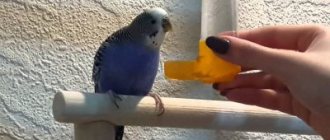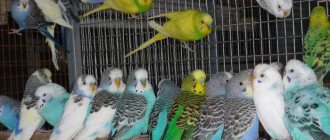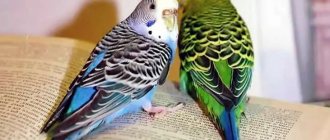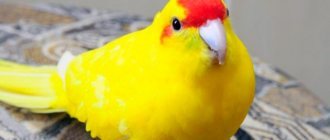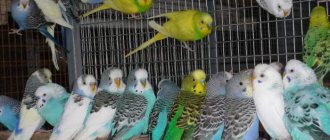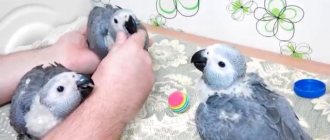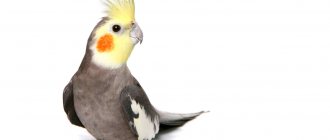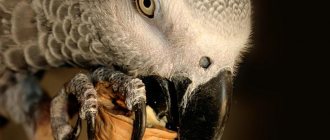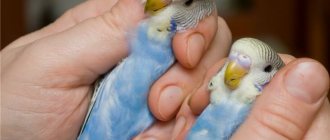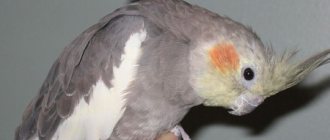Cockatiels and budgerigars are popular species of parrots that are often kept in captivity as pets. They are small in size, peaceful, sociable and easily tamed. These birds are similar in maintenance and care, so many novice bird lovers are wondering which of the two species to choose. Both cockatiels and budgies have their advantages and disadvantages, as well as their own characteristics that need to be studied before making a choice.
Corella or budgerigar
Corella and budgerigar make good companions. They are non-aggressive, willing to make contact with people, love to play and communicate, and are able to remember and repeat words and phrases. These birds do not require much space to keep them. They are not picky about food and are easy to care for, have strong immunity and a fairly high life expectancy.
Pros and cons of a budgie
The advantages of a budgie include:
- small size;
- peaceful character;
- ease of care and maintenance;
- no unpleasant odor;
- getting along with other animals and birds;
- bright color and variety of color variations;
- ease of breeding at home;
- good learning ability;
- availability for purchase and low cost.
The disadvantages include:
- noise;
- the need for daily cleaning of the cage (birds like to scatter food and splash water, and also leave a lot of droppings).
Pros and cons of cockatiels
Among the advantages of cockatiels are:
- unusual appearance;
- developed intelligence;
- sociability and curiosity;
- high learning ability;
- ease of maintenance and care;
- no unpleasant odor.
The disadvantages of this type are:
- dependence on the owner’s attention (if the owner does not communicate enough with the cockatiel, it may become depressed, get sick, or begin to behave aggressively);
- noise;
- the need for frequent cleaning of the cage and the space around it (parrots scatter food and droppings, and also produce feather powder, which covers all surrounding objects in the form of a white coating).
Who is the budgerigar suitable for?
Due to their size, budgies are well suited as pets for preschoolers. A small parrot is not capable of causing serious injury to a child even if frightened or undergoing unpleasant manipulations. Representatives of this species will happily play and communicate with their little owner.
The budgerigar is also suitable for bird lovers who are interested in genetics and breeding. This species has many color morphs and breeds, the selection of which is very interesting. Cages with parrots do not take up much space, so even in an apartment you can collect the livestock required for breeding work.
Who is Corella suitable for?
Cockatiels are larger than budgies, so they can inflict more serious injuries when defending themselves. In this regard, it is better to have them not for small children, but for teenagers. Cockatiels do not have such a bright color and variety of colors as budgies, but they are more intelligent. They are able to memorize up to 200 words, memorize phrases and poems, and imitate sounds. Cockatiels can be trained to perform a variety of tricks. Playing and communicating with these parrots is interesting for both children and adults. Such a pet can become a real family member.
So the main typical advantages of all three birds are:
However, there are also disadvantages that I would like to highlight separately, and which I also have to deal with every day, or rarely:
But all the disadvantages are of course outweighed by the advantages. At the moment I have 5 lovebirds (parents and chicks) and one budgie. Now I’ll tell you more about the experience of keeping all birds.
In terms of beauty, I would say that everyone has their own preferences, but the wavy looks the least exotic, unlike the cockatiel, which is approximately similar to a small cockatoo, and will differ quite well in weight on the hand. The lovebird is an average bird, and has more wavy birds, although not significantly. They all eat about the same, they litter - it all depends on the bird. If you happen to be a slob by nature, then nothing can save you. Another plus for the wavy and cockatiel is the ability to imitate human speech well, unlike the lovebird.
Experience with wavy. I've always had budgies. I want to say that it all depends on the bird and its character. So the first bird was super tame and no other animals were needed, since the bird replaced both a cat and a dog: the bird was 100% tame, spoke worse than a cockatiel, and was with its owner everywhere. Yes, you can only dream about this. He sang and talked a lot. He was really sloppy, there was plenty of garbage. Wavys have the most pleasant voice and chirping. It was also very easy to train him: his cage was always open and eventually the bird made contact on its own. The wavy “girl,” on the contrary, turned out to be very aggressive and never got used to humans in her life, although she was kept with a boy. We took the current parrot as a boy, since experience has shown that they are much better. But this is everyone's business. The deaths were due to carelessness: one was eaten by a cat, the second flew away at the dacha, the third contracted the infection from the street. Budgerigars are the cheapest.
Experience with lovebirds. I had no intention of getting lovebirds at all, but as fate would have it, we caught a bird on the street. A very good bird, but the voice is very specific and screams more than sings, this is a huge minus. And then it turned out that they were not talking yet. It turned out to be not difficult to treat (for scabies) the bird; it is not picky about its diet. Taming - the same, a constantly open cage, the bird quickly made contact and became tame. After acquiring the boy, she went wild, like all birds living in pairs. After the chicks appeared, both became very aggressive. But the chicks are just sweethearts (but I think this applies to all chicks), without being separated from their parents, but with constant contact they turned out to be tame very easily. In my opinion, lovebirds are very, very beautiful and cool, they are very inquisitive and active (I would say more active even than that super wavy one that we had), and you can feel it more strongly by the weight on your hand. There was not a single death, but the cat could not fight back. The birds are smart but impudent, they understand everything and do it to spite their owner. Unlike wavy and cockatiels, it has the strongest beak, which can bite quite hard. It is strictly forbidden to keep it with other birds. Average price category.
Experience with cockatiels. I got my experience with cockatiels from a very close friend of mine; I lived with cockatiels for about 6-7 months. To my memory, I saw 6 birds during this time. They died, alas, often, for some unknown reason, or they caught an infection or something. But the cockatiel’s owner didn’t take much care of them, and I think they partly died from poor care. Of course, you can feel the cockatiel on your hand, such a big bird with a cool crest. Most of all I liked the albino cockatiel, a really very beautiful bird. Alas, I couldn’t appreciate human imitation, but their screams are very disgusting (please don’t throw tomatoes at me, this is a purely subjective opinion). I couldn't stand these screams. Well, very nasty, much worse than those of lovebirds. Keeping a boy and a girl very quickly moved on to mating, even without a nest, so I think it’s easiest to hatch the chicks. The birds (all) were not willing to make contact, they mostly ran around the room and screamed heart-rendingly. They were afraid of literally everything. I can say that they are much more timid than lovebirds, they are also curious, but they are still inferior to them. The appearance is specific, not for everyone, some will like it, but others will not. Larger litter than the previous ones (very noticeable around the room). Corellas, like lovebirds, require a slightly larger cage than wavy birds. The cockatiel can be kept in the same cage as the wavy.
In general, all birds are good and depend more on their character than on a specific connection to the breed. If you are faced with a choice, ask yourself these questions:
In any case, no matter who you take, with good care, attention and communication, the bird will delight you and you will love it. Everyone has the disadvantages that were listed at the beginning, and without them you can’t get anywhere with a bird in your apartment. Cats and dogs are a threat to all birds. There will be garbage from everyone.
Source
Is it possible to keep in one cage?
Despite the fact that budgies and cockatiels are friendly birds that can get along with each other, it is not recommended to house them in the same cage. In conditions of limited space, skirmishes will inevitably occur between birds over food and the best place. Due to the difference in size, a cockatiel can seriously injure a budgie during a fight.
It is difficult to choose a cage and accessories for keeping birds of different sizes together. The cockatiel requires a large cage, but models of the appropriate size usually have bars that are too sparse. The budgie will try to get out through them and may get injured. In addition, it is impossible to select perches whose diameter would be suitable for representatives of both species. When sitting on perches that are too thin or too thick, birds will develop problems with their claws and joints.
The diet of medium and small parrots varies in composition. If you keep a cockatiel and a budgie in the same cage, they will eat each other's food. An unbalanced diet will lead to metabolic disorders and internal diseases.
To treat sick birds, medications are often mixed into the feed or water. When kept together, if one of the neighbors is ill, the other, healthy bird will also receive medication, which will negatively affect its health.
When using vitamin and mineral supplements, as well as medications, their dosage is calculated based on the body weight of the bird. When birds of different sizes are kept together, it is impossible to dose medications correctly.
If a budgie and a cockatiel of different sexes are kept together for a long time, they can form a pair. In this case, if the owner subsequently wants to get offspring from them, the birds will not be able to form a pair with representatives of their own species. They will be aggressive towards other parrots and will not accept them as sexual partners.
Description
Budgerigars
As everyone probably knows, these are bright, small birds, a little larger than an ordinary sparrow. The length of their body rarely reaches 20-21 cm; as a rule, it is much less. However, this species of the Parrot family seems larger due to its rather long tail (up to 10 cm).
Possibility of cohabitation between a cockatiel and a budgerigar
In their natural habitat, their color is predominantly grass-green, with variegated gray-black wings of a peculiar “wave” pattern. The same plumage on the upper part of the neck and the back of the head. Many years of selection work, however, have long brought out parrots of the most varied plumage colors - white, white-gray, pure yellow, blue. Waviness often persists, but not necessarily.
The bird is distinguished by a rather massive, strong beak for their build and a cere - a section of rough skin at its base.
These creatures are cheerful, active, sociable, but sometimes quite noisy. They have long been well adapted to living at home next to humans. They gained popularity due to the ability to “mimic” many sounds that they hear: the screams and even trills of other birds, individual words and phrases of human speech, coughing, bells, the grinding of a key in a keyhole and much more. All this makes the budgie fun to talk to and a beloved member of the family.
Budgie
Corella
This bird, otherwise called a nymph, is somewhat larger - the length of its body together with the tail is usually 30 or a little more centimeters. The crest on its head gives the bird a special elegance. It also indicates that the cockatiel belongs to the Cockatoo family.
The plumage is most often grayish with an olive tint, the head and crest are yellow, and there are bright spots on the cheeks of tangerine color. The beak is rounded and quite powerful.
The above color, of course, cannot be considered the only one. Breeders have worked hard here too: today, home zoos are home to nymph parrots of a wide variety of plumage variations.
When communicating with humans, these birds are also able to remember and reproduce words and short phrases, although they are much more willing to imitate the calls of birds from the street or from their home environment.
